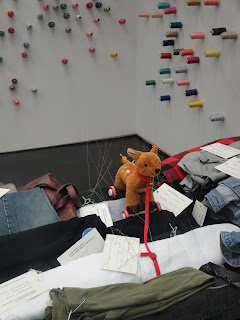John Bryne has recently taken us to visit the exhibition at Rapid hardware store, which is part of the Biennial. Before entering the exhibition John asked us to each pick a piece that we were most drawn to, a piece that interested us. He then posed a series of questions to us to open our minds to viewing and critiquing work differently.
What is interesting about it?
What is the artist trying to communicate?
Do they do this well?
Has the artist used the most appropriate medium for the meaning they are trying to get across?
How is Rapid curated, and is it affective?
The piece i chose to discuss was by the artist Lee Mingwei, titled 'The mending project'. The artists uses threads to stitch up torn or damaged clothes that the public bring into the gallery, but instead of hiding the rip he embraces it with colourful threads and sometimes adding beads. To me this is a beautiful way of commenting on how much as a nation we threw away. Normally when our clothes get damaged or torn we don't embrace it we simply throw the item away. this is what i find interesting about this piece, it got me thinking about as a individually person how materialistic i can sometimes be. This project made me think of global warming and the effect of our consuming ways on the plant. The piece deals with these ideas in a visual bright and dynamic way.
When walking into the gallery space there is a hanging on the door that say mending. i found this display of the piece welcoming and it gave me a sense of craft based work before even seeing the piece. i almost felt as if i was walking into the environment of the art not just walking into a room were the art is displayed. This 'mending' sign gave the piece an automatic atmosphere, as it closed of the viewer to any other piece of art work apart from Lee Mingwei.
In the biennial guide book it states that the work is 'Hemmed in by tailor's curtains to create an atmosphere of intimacy and calm', which it truly does.
I believe because of this way of creating a section of space the piece uses the layout of the rapid building to its advantage. Other than the architecture space of the room, the work has striped any relationship to the Rapid hardware store away, as like most galleries it has been white washed. To me this is not necessarily a bad thing as the white walls highlight all the individual coloured threads, and allowed me to follow each thread along to the garment it had mended. On the last day of the biennial the artist is going to cut the garments free to give them back to the owners. To me this is the being of the end of the project, i believe the project will never end as long as the owners are still wearing the clothes.
The activity of mending each garment is key to the ongoing project within the gallery space. The artist is creating the work on the clothes whilst in discussion with the audience. the artist asks the viewer to sit next to him whilst he stitch's the item of clothing. the idea of this relationship is key to the project!!
i wonder what will happen to the piece when the artist leaves, the artist can only stay for the first two weeks, then he has organised for other menders to take over. This relationship between the artist and his assistance is something that interests me. i wondered if Mingwei will be happy with the garments his assistance mend or whether he will be more critical of these garments. i am going to go to the gallery this week to see the other menders at work. i am interested in the origins of textile and craft based work and the idea that it is mostly a female orientate activity. The artist Mingwei is a male artist who uses sewing to get his message across effectively, i am interested to see if he gets female menders or male menders to carry on his work.




No comments:
Post a Comment